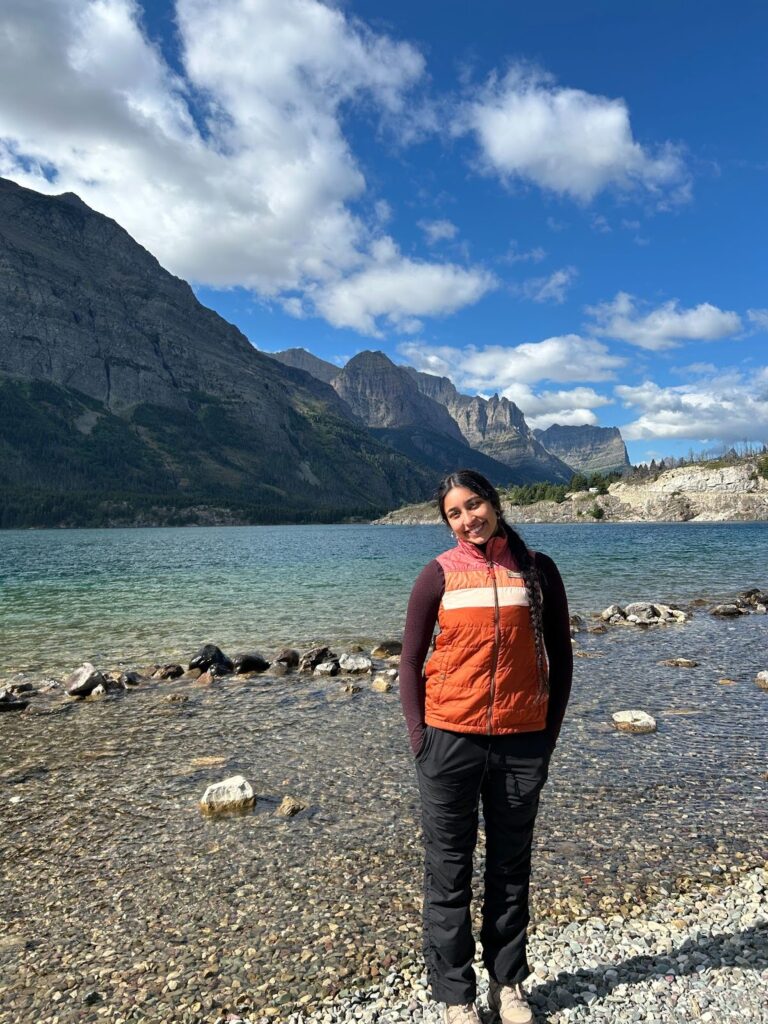When I first started my course, I thought my biggest takeaway would be environmental issues in Montana. I didn’t expect that being in the Blackfeet reservation would take me back across the world to Punjab, my ancestral home, and cause me to question how we care for land, water, and identity. We learned about the Blackfeet Nation’s story of their decades-long fight to stop oil and gas leases issued by the Reagan administration in the 1980s. The Blackfeet, whose home stretches along the Rocky Mountain Front in northern Montana, just east of Glacier National Park and the Canadian border, has fought for decades to protect their land and water. For over forty years, they resisted the exploitation of their sacred lands until the leases were finally canceled. As I listened I felt an uncomfortable recognition. The struggle they described to protect water, to defend rights, and to keep a living culture rooted in its place was one I had heard before, in a different language, in stories from my people.
Punjab once had the most advanced irrigation system in Asia. Its intricate canals and wells made it a farming paradise. Before British rule, Punjab’s rivers and fertile soils sustained thriving communities, culture, and trade. Punjab was a hub of global commerce, connecting markets to Persia, Central Asia, and beyond. But under colonial control, this abundance was re-engineered to serve colonialism. The British exploited Punjab’s farmers to fund their wars. During World War I and World War II, Punjab’s grain was shipped abroad to feed soldiers, while many in Punjab itself faced famine. Later, the Green Revolution transformed Punjab into the “Granary of India,” producing over 60% of India’s wheat. Yet today, many of those same farmers struggle for fair prices, drowning in debt and uncertainty. The story of prosperity has become one of ecological depletion and social despair.
Colonial legacies shaped today’s battles over canals and rivers, like the Sutlej-Yamuna Link Canal controversy, where Punjabis resisted having their water diverted to other states. These disputes raise deeper ethical questions about who owns a river, who gets to decide, and whether water should be treated as a commodity at all. This echoes the idea that ethics forces us to ask not just what is but what ought to be. What is in Punjab today is groundwater depletion, toxic rivers, and corporations buying up farmland for cement plants and textile factories. What ought to be is a vision where Punjab’s environment is valued not just instrumentally, as a means to produce grain or profit, but intrinsically, as life itself. Similarly, the Blackfeet’s fight over the Badger-Two Medicine illustrates the gap between what is and what ought to be. Leases and profit were the reality, but the deeper truth was that the land ought to be protected as sacred, irreplaceable, and vital to Blackfeet cultural survival.
As Holmes Rolston III reminds us: “Humans count enough to have the right to flourish there, but not so much that they have the right to degrade or shut down ecosystems, not at least without a burden of proof that there is an overriding cultural gain” (Rolston, 141). That “burden of proof” has rarely been met in Punjab.
The loss of water is not only ecological but cultural. In Punjabi literature, rivers are companions to love and memory. The famous romance folk story Sohni Mahiwal makes the Chenab River a witness to the lovers’ journey. But with reduced Himalayan snowmelt, erratic monsoons, and over-extraction, the Chenab of literature could soon exist only in stories. What happens to a culture when the landscapes in its stories vanish? Already, younger generations are watching the birds, animals, and rivers mentioned in the Guru Granth Sahib and Sikh history disappear from daily life, making it harder to see their traditions as alive. Birds such as the baaj (the northern goshawk) and the koonj (the sarus crane) are slowly disappearing from Punjab. Climate change threatens not only Punjab’s ecology but its language, spirituality, and identity.
Yet, environmental ethics is not foreign to Punjab. Agriculture itself has always been more than an economic act, it was a way of belonging. But mass migration to Western countries and environmental decline are breaking that bond. Farming becomes survival instead of culture, and land becomes commodity instead of identity.
My lesson from WRFI is that resilience requires courage. The Blackfeet Nation’s forty-year fight to protect sacred lands is proof that even decades are not too long to defend what matters. Aldo Leopold once wrote about marshes and cranes: “The ultimate value in these marshes is wildness, and the crane is wildness incarnate… to cherish we must see and fondle, and when enough have seen and fondled, there is no wilderness left to cherish” (Leopold, 95). Punjab’s rivers, fields, and wildlife have their own “wildness incarnate.” But if we wait until they are nearly gone to value them, we risk losing them altogether. The fight for Punjab’s environment is not only about saving crops or rivers – it is about protecting a way of life, a cultural identity, and an ethical vision of balance.

Works Cited
Leopold, A. (1949). A Sand County almanac and sketches here and there. New York, NY: Oxford University Press, pp. 89-95. [7 pp.]
Rolston III, H. (1998). Challenges in Environmental Ethics. In M.E. Zimmerman et al., eds. Environmental Philosophy: From Animal Rights to Radical Ecology (pp. 124-44). Upper Saddle River, N.J.: Prentice Hall. [21 pp.]